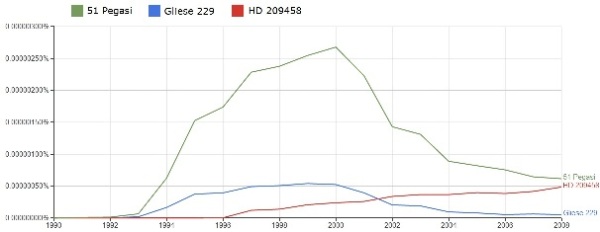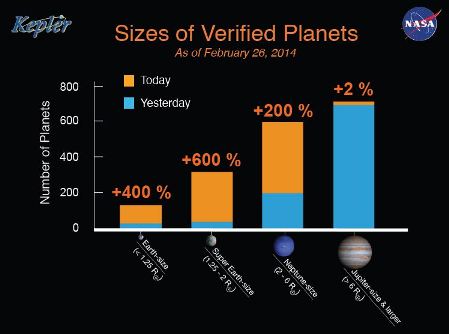
Mildly out-of-date computer.
It has been nearly 20 years since the discovery of the planet orbiting 51 Pegasi. What followed over the rest of the late 90s were the landmark discoveries of the first eccentric giant planets at 16 Cygni B, and 70 Vir, and the first two-planet system at 47 Ursae Majoris. As new discoveries are made that push the boundary of what is known, prior ones fade into distant memory.
The public interest in these objects also varies with time. It seems odd to think it today, but in the early 1800s, 61 Cygni was wildly more popular than Alpha Centauri. This was merely because at the time, only the former’s distance had been measured, but there does seem to be a correlation between the public interest in an object and its scientific importance. Consider for example three landmark discoveries, the first planet orbiting a sun-like star, the first confirmed brown dwarf, and the first known transiting planet (with stellar hosts 51 Pegasi, Gliese 229 and HD 209458, respectively).

Trends of interest in three landmark discoveries
51 Pegasi becomes wildly famous, and rightfully so being the first of its kind known. Even today most people with a casual interest in astronomy know why 51 Pegasi is important. Gliese 229 has never really reached the prestige of 51 Pegasi — brown dwarfs just aren’t as exciting, and as time went on, interest faded. What started out as just another hot Jupiter became the most important when it was found to transit, and interest in it has continuously increased over the timeframe allowable to me by Google Ngrams.
As time went on, new planets stopped grabbing people’s attention unless they were set apart by some level of spectacularity. From memory alone, what do you know about the planet HD 290327 b? If you’re like me, absolutely nothing. Still, over time new planets and planetary systems were announced that were genuinely interesting. At the turn of the century, the first super-Earths at Gliese 876 and 55 Cancri held our attention for a while, followed by our first transiting Neptune-mass planet at Gliese 436. HD 69830 and HD 40307 gave us our first multi-planet systems made up of sub-Jovians in the mid-to-late 2000s. CoRoT broke ground with the first transiting super-Earth at the end of the decade and a multi-planet system was imaged at HR 8799.
Throughout this evolution of the kinds of things that have kept our attention, it is truly remarkable to pause and realise how numb we seem to have become to some discoveries. The discovery of Earth-sized planets now occurrs so often that it does not even raise an eyebrow anymore. The time between when a type of discovery goes from immensely exciting to just-another-day-at-arXiv seems to be only on the order of a couple years or so. It almost appears that there seems to be a sort of Moore’s Law at hand for extrasolar planet discoveries as there is with computers.
Earlier this month, the Kepler team made public about 700 new planets. Keep in mind we only just recently achieved a total of a thousand known planets. Now we’re knocking on the door of two thousand known planets. These planets are all in multi-planet systems, which is the foundation of the statistical argument used to validate their existence — a single transiting planet candidate can be any number of false positives, but having multiple candidates in a system is much harder to emulate by a non-planetary phenomenon. Many of the planets are Earth-sized and super-Earth sized, with considerable gains in transiting Neptune-sized planets.

New Kepler Planets
To further drive home the point, among the new Kepler planets are four new habitable planet candidates (at Kepler-174, Kepler-296, Kepler-298 and Kepler-309). At least that’s what they’re being called — it is my assertion that their radii are much more consistent with being low-mass, low-density “mini-Neptunes” or “micro-Jovians.” The combined interest in these four new habitable zone planets is less than half the public interest in Kepler-22 b, for example.
Much closer to home, RV studies on M dwarf stars have yielded eight new planets in the solar neighbourhood, and constrained the frequency of planets around M dwarf stars.
According to our results, M dwarfs are hosts to an abundance of low-mass planets and the occurrence rate of planets less massive than 10 M⊕ is of the order of one planet per star, possibly even greater. …
They, too, report new habitable planet candidates, but their minimum masses are, again, consistent more with being more closely reminiscent of Neptune than Earth. Regardless, it is my opinion that this is actually more interesting than the 700 new planets from Kepler. By now, we know that planets are common. The Galaxy is drowning in planets and while new planets are great for population statistics, individual planet discoveries don’t count for anywhere near what they used to. We are moving from an era of having the attention and focus on planet detection and discovery to an era of planet characterisation. We’re hungry for planets that are actually accessible to HST, Spitzer, Keck and soon(-ish) JWST for transmission spectroscopy and eclipse photometry. New planet discoveries in the solar neighbourhood count for far more than Kepler planets because the nearby planets are the ones that we have a shot at studying in-detail from direct imaging in the near future.
They also report the existence of a Neptune-mass planet in a fairly circular, 400-day orbit around Gliese 229, bringing perhaps a little more relevance and attention to a star that saw its moment of fame twenty years ago.